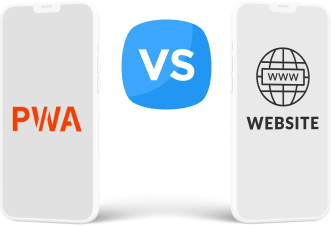PWA Vs Website
The evolution of e-commerce has made it more critical than ever to own a website for each online business. However, the development of technology has also come with the introduction of other software to improve users’ experience such as Progressive Web App (PWA). This post will focus on the comparison between PWA vs Website.
First appearing in 2015, Progressive Web App never ceases to be the hot topic among merchants in the online shopping industry. Many questions whether PWA makes so many differences to the website to level up the browsing experience from web visitors.
This post will explain it all!
Contents
PWA vs Website: Similarities
Same interface for desktop
After integrating PWA, the storefront viewed from computers will go through some slight changes after PWA integration, but the layout is basically the same.

Thus, customers who are used to the design from the original website will not face any difficulties when switching to PWA.
Discoverability
PWA maintains the link from the website. This means that PWA integration does not impact the site discoverability as it still can be indexed by Google and appear on Google search results.

Popularity maintenance
As the URL from the website is maintained on PWA, users can still share any content they like from PWA on their social media accounts. On-page and off-page SEO optimization for PWA works the same way with the website.
Also, PWA development does not interrupt the current Google and Facebook ads running on the site.
Easy management
While PWA integration changes the site structure, it still keeps the backend from the original website. Thus, it is easy for managers to control their online store, including operating the business (managing product, category, customers, orders, inventory), updating CMS pages and banners.
Statistics report
It is still possible to integrate Google tools like analytics, search console, tag manager,… This helps store owners manage their store more effectively, make improvements when necessary, diagnose any problem causing a decrease in sales and tackle immediately.
Responsiveness

Both websites and PWA can have responsive designs to fit different screen sizes. We know that most normal websites are suitable for laptop users only. The website’s size may not match the devices with smaller screens, and it is harder to locate buttons on the website.
Responsive layout eliminates this concern as the store interface is now suitable for any device regardless of the screen size.
PWA vs Website: Differences
Speed

PWA is probably the winner as it has a faster loading speed (thanks to the Service Workers). Preloaded pages take no time to load.
Normal websites take longer to load, and whether you have seen the page before or not, it still takes the same amount of time. Also, PWA tries to comfort users while waiting for the pages they want to appear to establish a stick header and navigation.
Thus, the loading time is not for the whole website but only the content below the header and navigation.
Many big companies have done PWA development and confirmed that it really brings about lightning loading speed.
Makemytrip reduces loading time by 38% after upgrading to PWA. The loading time for Tinder decreased from 11.9 sec to 4.6 sec. Uber also shares positive reviews about PWA as their site needs only 3 seconds to load, even on the 2G network connection.
Structure
PWA integration also alters the original structure of the site (frontend/ backend). The new structure includes Storefront and backend, API links these two parts.
For the original website, the frontend and backend are closely related. Any changes on the storefront will require a tremendous amount of effort to adjust related parts in the backend. Thus, this takes both time and money to hire developers to complete these tasks.
Plus, any wrong configuration from the backend will result in disruption of the operation of the storefront. This directly impacts the shopping experience of current customers. Some buyers might lose their trust in the brand as technical issues might imply that the company might serve an outdated website or face some security issues (being hacked,…).
PWA fixes all the issues mentioned above with the new structure. As a result, the changes on the storefront can be updated more quickly, and the stability of the web performance increases. Further information will be explained in the next chapter, “Headless PWA”.
Mobile-friendliness

Responsiveness is usually not enough to improve the mobile shopping experience. PWA is more than just a responsive design. PWA can also create a separate design for mobile users to ensure the best browsing experience.
The URL bar is hidden to show a larger screen and display more products. This saves scrolling time for customers, and they can quickly spot the products they want. The longer it takes to find something they need, the more likely they will change their minds and give up on the buying decision.
Plus, customers are presented with the splash screen – a logo page during waiting time. By contrast, the normal website shows a blank page that easily annoys users and increases the likelihood of escaping the site.
Safety
PWA alters HTTP to HTTPS (in case the URL of the website is HTTP). Thus, it brings about better security, and this element is crucial in building brand loyalty.
Hackers are becoming more dangerous with the development of technology. Merchants with great technical expertise usually cannot do anything once attacked by those online criminals.
Any incidents like stealing information of customers (personal data, bank account number,…) can easily ruin the company’s reputation. Therefore, the only solution is to add more security layers to the site to protect the store and the customers as well.
App-like features
We always know that the drawback of using websites on the phone is not only due to the layout. The features from the app are the key weapons that native apps use to beat websites when it comes to surfing on mobile phones.
PWA fixes this puzzle by adding app-like functions on their website:
- Add to home screen: PWA can also be “installed” like apps. A pop-up message will appear on the site to guide users on downloading PWA on the device. The installation process is done within a few seconds due to the lightweight.
- Offline mode: This allows access to pages that are preloaded from PWA. Customers do not need to connect their devices to any network to view this content.
- Push notification: This feature from PWA shares the exact mechanism with notifications from apps. They all appear on the home screen and customers can quickly access the store by tapping the reminder.
- Background sync: PWA saves customers from losing their orders when a sudden disconnection takes place. The last action that customers complete on the site will be saved and the order information will be sent to merchants when the network is connected again.
SEO Optimization

PWA can assist merchants with the SEO optimization process. Two key criteria that Google uses to rank websites are the loading speed and the level of mobile-friendliness. PWA meets both standards with the lightning loading speed and adjustments on content and design for different gadgets.
Also, with a better shopping experience, PWA integration minimizes the bounce rate and increases session duration.
Pinterest has got excellent results after PWA integration with a 40% increase in time spent by mobile users compared to the original site.
Housing.com also gets good news from their PWA version, with bounce rate dropping by 40% and a 10% rise in average time-per-session.
Marketing Cost
PWA can also work as a zero-cost marketing campaign. The popularity of different social network platforms enables merchants to reach users from different channels (email, Facebook, SMS,..).
However, the problem lies in the cost and the effectiveness of these marketing tools. Take email, for example. Emails are usually separated into different categories, and the advertising email will usually fall in the promotion or even the spam. These are the types of emails that users highly ignore.
Thus, the likelihood that customers will open these emails is really low. By contrast, the push notification from PWA will appear right on the screen, and customers can read a brief description of the upcoming events at the store.
Merchants need to spend no money on sending push notifications from PWA, and it can quickly reach users than other media communication channels.
PWA Vs Website: A Battle With The Winner Revealed As PWA
Overall, the comparison of PWA vs website has clearly pointed out that PWA can be considered an upgraded website version. It fixes most of the normal websites’ weaknesses and adds what people like about the native apps on the web.
